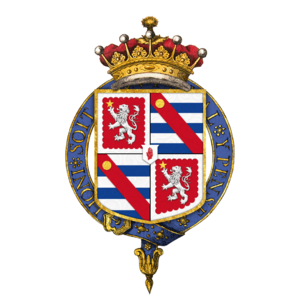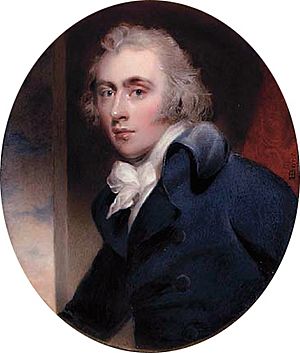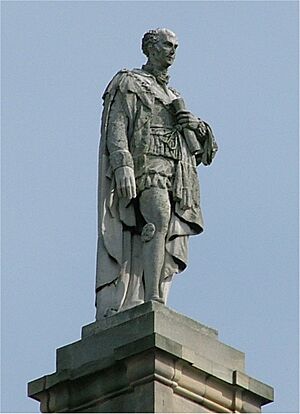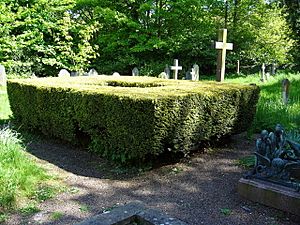Charles Grey, 2nd Earl Grey facts for kids
Quick facts for kids
The Earl Grey
|
|
|---|---|
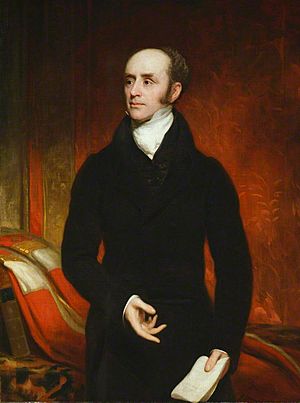
Portrait by Thomas Phillips, c. 1820
|
|
| Prime Minister of the United Kingdom | |
| In office 22 November 1830 – 9 July 1834 |
|
| Monarch | William IV |
| Preceded by | The Duke of Wellington |
| Succeeded by | The Viscount Melbourne |
| Leader of the House of Lords | |
| In office 22 November 1830 – 9 July 1834 |
|
| Preceded by | The Duke of Wellington |
| Succeeded by | The Viscount Melbourne |
| Secretary of State for Foreign Affairs | |
| In office 24 September 1806 – 25 March 1807 |
|
| Preceded by | Charles James Fox |
| Succeeded by | George Canning |
| Leader of the House of Commons | |
| In office 24 September 1806 – 31 March 1807 |
|
| Preceded by | Charles James Fox |
| Succeeded by | Spencer Perceval |
| First Lord of the Admiralty | |
| In office 11 February 1806 – 24 September 1806 |
|
| Preceded by | The Lord Barham |
| Succeeded by | Thomas Grenville |
| Member of the House of Lords | |
| Hereditary peerage 15 November 1807 – 17 July 1845 |
|
| Preceded by | The 1st Earl Grey |
| Succeeded by | The 3rd Earl Grey |
| Member of Parliament for Northumberland |
|
| In office 14 September 1786 – 14 November 1807 |
|
| Preceded by | Lord Algernon Percy |
| Succeeded by | Earl Percy |
| Personal details | |
| Born | 13 March 1764 Fallodon, Northumberland, England |
| Died | 17 July 1845 (aged 81) Howick, Northumberland, England |
| Political party | Whig |
| Spouse | |
| Children | 16, including Henry, Charles, Frederick, and Eliza Courtney (illegitimate) |
| Parent |
|
| Relatives | House of Grey (family) |
| Alma mater | Trinity College, Cambridge |
| Signature |  |
Charles Grey, 2nd Earl Grey (born March 13, 1764 – died July 17, 1845) was a British politician. He was a member of the Whig Party. From 1830 to 1834, he served as the Prime Minister of the United Kingdom. He is also famous because Earl Grey tea is named after him.
Grey was a strong supporter of important changes in Britain. During his time as prime minister, his government passed two major laws. The Reform Act 1832 changed how people voted for members of the House of Commons. This law allowed many more people to vote. The Slavery Abolition Act 1833 ended slavery in most parts of the British Empire. This was a huge step forward for human rights.
Grey was against the policies of William Pitt the Younger in the 1790s. Later, in 1807, he left his job as Foreign Secretary because King George III would not agree to Catholic emancipation. This meant allowing Catholics more rights. Grey eventually left his role as prime minister in 1834 due to disagreements about Ireland. Many historians believe that Grey helped prevent major problems in Britain and paved the way for progress in the Victorian era.
Contents
Charles Grey: A British Leader
Early Life and Education
Charles Grey came from a well-known family in Northumberland, England. He was the second son of General Charles Grey, but he was the oldest son who survived. His parents were General Charles Grey, 1st Earl Grey, and Elizabeth Grey. Charles had four brothers and two sisters.
He went to Richmond School, then Eton College, and later Trinity College, Cambridge. He was very good at Latin and writing in English. This helped him become one of the best speakers in Parliament during his time.
Starting in Politics
In 1786, when he was just 22 years old, Grey was elected to Parliament for the Northumberland area. He joined a group of Whig politicians, including Charles James Fox. Soon, he became one of the main leaders of the Whig party.
Grey was a strong supporter of changing Parliament and giving more rights to Catholics. In 1806, Grey became Lord Howick because his father was given the title of Earl Grey. He joined a government called the "Ministry of All the Talents" and became the First Lord of the Admiralty.
Later that year, after Charles James Fox died, Lord Howick became the Foreign Secretary and the leader of the Whigs. However, this government ended in 1807. King George III refused to allow new laws that would give more rights to Catholics. Lord Howick refused to promise not to bring up the issue again, so he resigned.
Years in Opposition
After 1807, Grey spent 23 years in opposition. This meant his party was not in power. He became Earl Grey after his father passed away. During this time, he often disagreed with the government's decisions. For example, he was not always convinced that Britain could win against Napoleon in the Napoleonic Wars.
In 1826, Grey stepped down as the Whig leader. He felt that the party was not listening to his ideas anymore.
Important Reforms as Prime Minister
In 1830, the Whigs finally returned to power, and Charles Grey became prime minister. This was after the death of King George IV and the resignation of the Duke of Wellington. In 1831, Grey was given a special honor called the Order of the Garter.
His time as prime minister was very important. He oversaw the passing of the Reform Act 1832. This law changed the way people voted for members of Parliament, making the system fairer. He also led the government to pass the Slavery Abolition Act in 1833. This law ended slavery in most of the British Empire.
Grey was careful with new reforms because he knew the King was not always keen on big changes. He also helped plan a new colony in South Australia in 1831.
However, disagreements about Ireland led to the end of Grey's time as prime minister in 1834. His government was divided on how to handle issues there. Grey decided to retire from public life. He seemed to prefer a quiet life, and his colleagues even joked that he often threatened to resign.
Lord Grey's Government (1830–1834)
Here are some of the key people who worked in Lord Grey's government:
- Lord Grey — First Lord of the Treasury (like the Prime Minister) and Leader of the House of Lords
- Lord Brougham — Lord Chancellor (a senior legal and political role)
- Lord Lansdowne — Lord President of the Council
- Lord Durham — Lord Privy Seal
- Lord Melbourne — Home Secretary (in charge of internal affairs)
- Lord Palmerston — Foreign Secretary (in charge of international relations)
- Lord Goderich — Secretary of State for War and the Colonies
- Sir James Graham — First Lord of the Admiralty (in charge of the Navy)
- Lord Althorp — Chancellor of the Exchequer (in charge of money) and Leader of the House of Commons
- Charles Grant — President of the Board of Control
- Lord Holland — Chancellor of the Duchy of Lancaster
- The Duke of Richmond — Postmaster General
- Lord Carlisle — Minister without Portfolio
Life After Politics
After retiring, Grey went back to his home at Howick. He still watched what the new government was doing. He often worried about the influence of Irish politicians like Daniel O'Connell. Grey believed that his Reform Act was a final solution for voting issues. He wanted future changes to happen slowly, as society became more intelligent and needs changed.
Family Life

Charles Grey had a daughter named Eliza Courtney (born 1792 – died 1859). She later married Robert Ellice.
On November 18, 1794, Grey married Mary Elizabeth Ponsonby. They had a large family with ten sons and six daughters between 1796 and 1819. Some of their children included:
- Louisa Elizabeth Grey (1797–1841)
- Elizabeth Grey (1798–1880)
- Caroline Grey (1799–1875)
- Georgiana Grey (1801–1900)
- Henry George Grey, 3rd Earl Grey (1802–1894)
- General Charles Grey (1804–1870)
- Admiral Sir Frederick William Grey (1805–1878)
- Mary Grey (1807–1884)
- Admiral George Grey (1809–1891)
- Rev. John Grey (1812–1895)
- Rev. Francis Richard Grey (1813–1890)
- Captain Henry Cavendish Grey (1814–1880)
- William George Grey (1819–1865)
Three of their children died young: an unnamed daughter (stillborn, 1796), William Grey (1808–1815), and Thomas Grey (1810–1826).
Later Years and Death

Grey spent his final years peacefully at his home in Howick. He enjoyed his books, his family, and his dogs. A sad event for him was the death of his favorite grandson, Charles, at age 13. Charles Grey became very weak in his last years. He passed away quietly in his bed on July 17, 1845. He was buried at the Church of St Michael and All Angels in Howick.
His Legacy Today
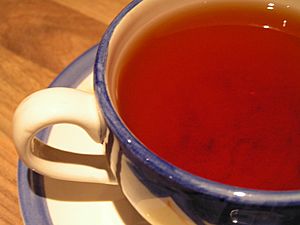
Charles Grey is remembered in several ways:
- Grey's Monument in the center of Newcastle upon Tyne is a tall column with a statue of Lord Grey on top. It is about 40 meters (130 feet) high. The monument was damaged by lightning in 1941, which knocked off the statue's head.
- The Monument Metro station in Newcastle is named after this monument.
- Grey Street in Newcastle upon Tyne, which starts near the monument, is also named after him.
- Durham University has a college named Grey College. This is because Grey, as prime minister, supported the law that created the university in 1832.
- Earl Grey tea, a popular tea flavored with bergamot oil, is widely believed to be named after Charles Grey.
See also
 In Spanish: Charles Grey para niños
In Spanish: Charles Grey para niños


